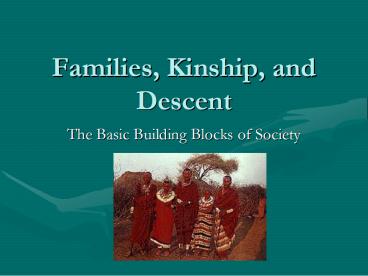Families, Kinship, and Descent - PowerPoint PPT Presentation
1 / 20
Title:
Families, Kinship, and Descent
Description:
Family, Kinship, Descent ... A family is the basic unit of the social group. ... Lineages ('the family line/tree') Clans (groups assuming common ancestry) ... – PowerPoint PPT presentation
Number of Views:1777
Avg rating:3.0/5.0
Title: Families, Kinship, and Descent
1
Families, Kinship, and Descent
- The Basic Building Blocks of Society
2
Family, Kinship, Descent
- The way in which people behave toward one another
is based on they perceive their role this role
in most societies is defined by whom one is
related to. - As we shall see, many aspects of kinship and
descent are socially constructed, as is race.
3
Some New Terminology
- Affinals relatives by marriage.
- Matrilineal descent kin reckoned through the
mothers lineage. - Patrilineal descent kin reckoned through the
fathers lineage. - Bilateral descent kin reckoned through both
sides of the family. - Matrilocal marriage residence at the mothers
family house. - Patrilocal marriage residence at the fathers
family house.
4
Whats so special about family?
- A family is the basic unit of the social group.
- Anthropologists are interested in looking at
families and how they reckon kin since kin
behavior has specific rules in each culture.
5
Types of families
- Nuclear family (husband, wife, offspring).
- Extended family (family consisting of three or
more generations). - Other descent groups include
- Lineages (the family line/tree)
- Clans (groups assuming common ancestry).
6
Types of nuclear families
- Families of orientation (family you are born into
and raised with). - Family of procreation (formed when one marries
and has children). - Nuclear family organization is widespread but not
universal other descent groups and extended
families sometimes fill the role of the nuclear
family.
7
Muslims of Western Bosnia
- Nuclear families lacked autonomy.
- Several families were embedded in an extended
family household called a zadruga. - Each zadruga is headed by a head male and his
wife (the senior wife). - Each family has its own sleeping room, but all
material possessions are used by any member of
the zadruga. Zadrugas are patrilocal.
8
The Nayar of Southwest India
- A large and power caste that lives in large,
extended matrilineal families. - The matrilineal compounds are called tarawads.
- Each tarawad is headed up by a senior woman.
- Marriage a formality men would return to their
mothers tarawad a few days after marriage. - Nayar women frequently have multiple sexual
partners biological fathers are not significant
in this particular kin system.
9
Industrial Nuclear Families The New
Hunter/Gatherers?
- Offspring, once grown, leave the family of
orientation to begin their own family of
procreation. - The new families are highly mobile, selling their
labor rather than their crops. Postmarital
residence is neolocal. - Their mobility and emphasis on small,
economically self-sufficient family units make
industrial nuclear families similar to foragers.
10
Changes in American Kinship
- Nuclear families important unit for several
groups. - Expanded households common among the lower
classes (an adaptation to poverty?). - Number of alternative household organizations are
becoming more commonplace (single-parent
families, singles, childless couples, etc.).
11
Descent Groups
- Descent groups are permanent social units whose
members believe they have ancestors in common. - Descent groups are frequently exogamous.
- Unilineal descent is kin reckoning through one
side of the family (matrilineal or patrilineal). - Bilateral descent reckons through both lineages.
12
Lineages and Clans
- Common to both types of descent groups is the
belief in an apical ancestor(s) (among
Christians, this would be Adam and Eve). - Lineages differ from clans in that lineages use
demonstrated descent (the actual genealogy can be
cited). - Clans have stipulated descent (they just say they
are related because they want to be!).
13
Apical Ancestors
- Apical clan ancestors are commonly nonhuman, and
may be an animal or plant (a totem). - Common clans of Northwest Coast Indian groups
include Raven and Wolf.
14
Kinship Calculation
- Ego refers to the reader.
- MBS mothers brothers son.
- MBD mothers brothers daughter.
- MZS mothers sisters son.
- MZD mothers sisters daughter.
- FBS fathers brothers son.
- FBD fathers brothers daughter.
- FZS fathers sisters son.
- FZD fathers sisters daughter.
15
Kinship Terminology
16
Lineals, Collaterals, and Affinals
17
Lineal Kinship Terminology (what we use)
18
Bifurcate Merging Kinship
19
Generational Terminology (parents and siblings
have the same terms)
20
Bifurcate Collateral Terminology (Everyone gets
their own term!)

